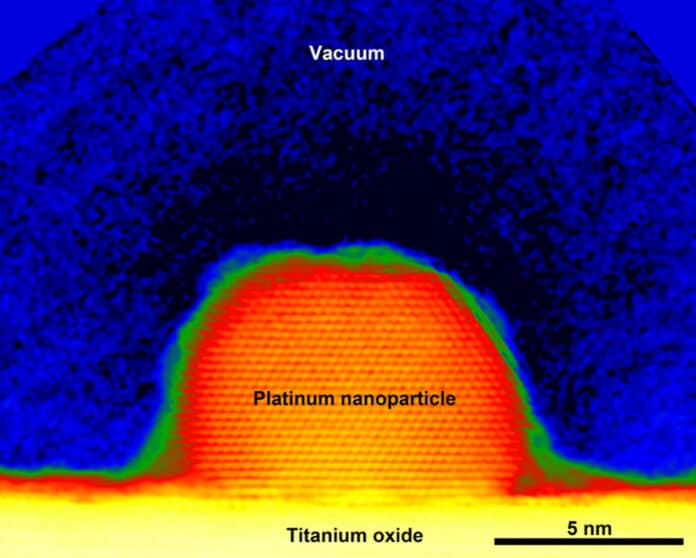A goal in the characterization of supported metal catalysts is to achieve particle-by-particle analysis of the charge state strongly correlated with the catalytic activity.
Scientists from Japan have now counted the additional or missing charges in a single platinum nanoparticle with a diameter that is barely a hundredth of that of typical viruses.
Led by Kyushu University and Hitachi Ltd., the research team achieved this feat of extreme counting through hardware and software improvements that increased tenfold the sensitivity of a technique called electron holography.
Electron holography takes advantage of the electrons’ wave-like characteristics to examine electric and magnetic fields, in contrast to transmission electron microscopy, which uses an electron beam to analyze materials down to the atomic level.
When an electron interacts with fields, its wave undergoes a phase shift that may be seen by contrasting it with the reference wave of an unaffected electron.
Scientists in this new study focused their microscopes on single nanoparticles of platinum on a surface of titanium oxide. On average, the platinum nanoparticles had diameters of only 10 nm—so small that it would take nearly 100,000 to span one millimeter.
Ryotaro Aso, associate professor at Kyushu University’s Faculty of Engineering and first author of the paper in the journal Science said, “While each particle contains a few tens of thousands of atoms of platinum, the addition or removal of just one or two negatively charged electrons causes significant changes in the behavior of the materials as catalysts.”
Measuring the fields just around a platinum nanoparticle—which vary depending on the imbalance of positive and negative charges in the particle—in an environment free of air, the researchers could determine the number of extra or missing electrons creating the fields.
Aso said, “Amongst the millions of positively charged protons and negatively charged electrons balancing each other out in the nanoparticle, we could successfully tell if the number of protons and electrons was different by just one.”
“Although the fields are too weak to be observed using conventional techniques, the researchers increased sensitivity by employing a cutting-edge 1.2-MV atomic-resolution holography microscope developed and run by Hitachi that lessens mechanical and electrical noise, processing the data to separate the signal from the noise further, and finally using the results to confirm their findings.
The signal processing method, created by Yoshihiro Midoh of Osaka University, one of the paper’s co-authors, used the so-called wavelet hidden Markov model (WHMM) to lessen noise without deleting the extremely weak signals of interest.
The scientists could determine the charge state of each nanoparticle and link variations in the electron count, which ranged from one to six, to variations in the crystal structure of the nanoparticles.
Yasukazu Murakami, professor at Kyushu University’s Faculty of Engineering and supervisor of the Kyushu U team, said, “By combining breakthroughs in microscopy hardware and signal processing, we can study phenomenon on increasingly smaller levels.”
“In this first demonstration, we measured the charge on a single nanoparticle in a vacuum. In the future, we hope to overcome the challenges that prevent us from doing the same measurements in the presence of gas to get information in environments closer to actual applications.”
Journal Reference:
- Ryotoaro Aso et al. Direct identification of the charge state in a single platinum nanoparticle on titanium oxide. Science. DOI: 10.1126/science.abq5868
